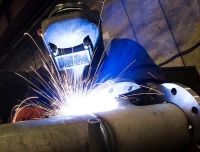
There are three common types of corrosion which are most likely to occur in the weld or weld area:
- Pitting corrosion
- Intergranular corrosion in the HAZ
- Selective corrosion
All can be reduced by correct welding practice but this often is not the case. The need to identify corrosion problems occurs at three times:
- Before the weld is made (to identify the best weld material for the job).
- After the weld is made (to check on correct weld technique).
- After weld failure (to find out the why and wherefore).
Here at ACM we have worked since 1986 with some of the world's leading welding institutes to address the problem of weld monitoring using electrochemical techniques. The preferred method is to take a cross section through the weld and section out the parent metal on each side of the weld. The heat affected zone on each side is also cut out leaving a piece of central weld metal. These are made into electrodes by the usual metallurgical methods ready for the test.
Each one of these five separate weld sections is then wired to its own individual Zero Resistance Ammeter. This then allows the electrochemical response from each section to be measured simultaneously and at the correct couple potential. To achieve this a potentiostat with its count resistor and reference electrode is needed to complete the channel. So a single channel instrument to test a weld consists of five autoranging ZRAs and a potentiostat plus analysers and sweep generators. This complexity of equipment has deterred many researchers in the past, but help is now at hand with the development of the ACM Instruments Weld Tester. Combining the five ZRAs, potentiostat, sweep generator, DC measurement stage plus AC Impedance generator and analyser into one instrument as well as sequential switching between more than one channel this is the best instrument for testing welds. The Weld Tester is available from one to twelve channels, complete with the standard DC and AC single channel software plus special weld test software, both AC and DC offering cyclic sweeps, LPR, potentiostatic, current and voltage, AC impedance, harmonic analysis etc. all on the 5 segments simultaneously. There is no equivalent anywhere in the world. For the scientist whose job depends on electrochemical testing of welds this instrument is perfect, and, with it's ability to act as a standard Gill 8, it can be used for any other electrochemical testing that is required.
See Application Notes for more information on AC Impedance, welds, Current and Voltage Noise and LPR techniques.
See Downloads for instrumentation datasheets.
Recommended Instrumentation
- Weld Tester
- Gill AC with Weld Test option
